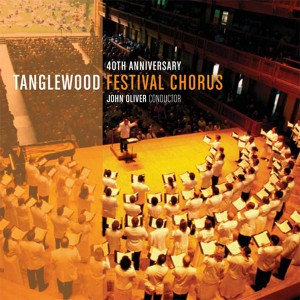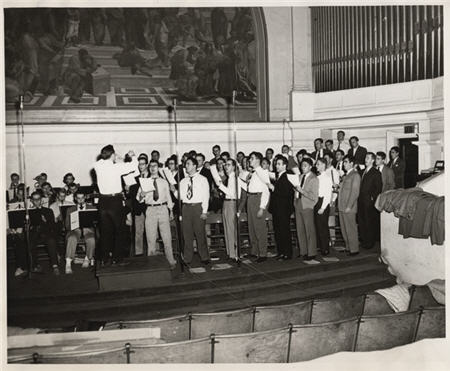
This year’s CD release of Tanglewood Festival Chorus: 40th Anniversary marks a number of interesting milestones. First, it is the first time the TFC has headlined a recording (rather than participating alongside the BSO or Pops, or on a soundtrack) since 1983’s Nonesuch recording Kurt Weill: Recordare/Dallapiccola: Canti di Prigionia (surely a collector’s item now). Second, of course, it celebrates the 40th anniversary of the chorus in a significant, tangible way.
Third, and best of all, it collects examples of the superb Prelude concerts that the TFC has put on at Tanglewood over the last ten years in the evocative space of Seiji Ozawa Hall. (Disclaimer for all superlatives: I don’t sing on any of the performances on this disc, so my conflict of interest as a reviewer is minimal.)
The repertoire is a mix of old friends (the Lotti “Crucifixus”, Bruckner motets, Bach’s “Singet dem Herrn Ein Neues Lied”) and slightly less familiar works (the Martin Mass is performed in its entirety here). Reception to the disc has been good; Jeremy Eichler of the Boston Globe singles out the Bruckner “Virga Jesse Floruit” for “robust and hearty singing,” and calls the Bach a “wonderfully vibrant performance” and “the highlight of the disc.”
For me, the highlight is the closing work, Copland’s “In the Beginning.” I’ve sung the work twice in performance with various groups and the TFC performance recorded here is simply superb, beginning with the performance of soprano Stephanie Blythe and carrying through all the chromatic chord changes, tricky rhythms, and shifts of mood as the Genesis story unfolds.
And that’s no small trick: the Copland is a work with many layers. The piece is in no specific key or meter, but visits about twelve different tonalities throughout, all with hummable melodies and each yielding to the next in a slow chromatic rise of pitch throughout the piece until the final lines are sung in an ecstatic seventh above where the music started. And the work embodies multiple shifts in musical voice, neatly signalling the (presumed) change in authorial voice from the P author (Genesis 1:1 – 2:3) to the Redactor (Genesis 2:4a, “These are the generations”, which Copland’s performance direction indicates should be sung “rather hurriedly,” as if to get it out of the way), and then the conclusion, the story of the creation of Man as told by the J author, the oldest part of the story, which seems to rise out of the mist like the clay that is fashioned into man and breathed full of the divine breath. (Wikipedia has a good summary of the theory of differing authorial voices in Genesis.)
The TFC performance neatly captures all the layers of the work–the differing sections are full of the excitement and exultation of creation and then, in the end, its mystery and a more solemn gladness. Until now, I don’t think I had a good reference recording for the work; this certainly qualifies. The overall effect of the recording is captured in the summation of the brief Globe review: “Oliver conducts eloquently in this well-deserved recognition of the chorus’s anniversary year.”
Originally written for the Tanglewood Festival Chorus newsletter.

